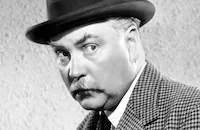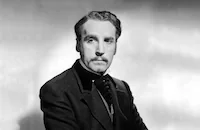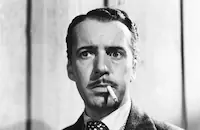The Woman in Green

Brief Synopsis
Cast & Crew
Roy William Neill
Basil Rathbone
Nigel Bruce
Hillary Brooke
Henry Daniell
Paul Cavanagh
Film Details
Technical Specs

Synopsis
In turn-of-the-century London, a group of Scotland Yard's best investigators meet to discuss the fourth in a series of murders of young women, which have become known as the "finger murders" as each victim is found with one finger severed. Inspector Gregson, in charge of the investigation, informs his men that due to rising public concern about the murders, he intends to bring famed private detective Sherlock Holmes in on the case. Holmes and his partner, Dr. John Watson, meet Gregson at the morgue to examine the latest victim and then go to the Pembroke House club to discuss the case.
While there, Holmes notices Sir George Fenwick in the company of an attractive woman, Lydia Marlowe. Shortly afterward, Fenwick and Lydia depart for her apartment, where Fenwick is unknowingly drugged and hypnotized by Lydia with the help of her maid. The next day Fenwick awakens in a strange boardinghouse, groggy and confused, and hears from news vendors on the street that another "finger murder" has been committed. To his horror, Fenwick finds a severed finger in his pocket. When he returns to Lydia's to inquire about the previous night, he is met by a stranger, who unknown to him is the notorious Professor Moriarty. Moriarty informs Fenwick that he has recovered incriminating letters suggesting Fenwick is involved in the latest "finger murder." The following day Holmes and Watson receive a visit from Maude Fenwick, who confesses that her father has been behaving strangely and that she discovered he had buried a human finger in their garden.
When Holmes and Watson accompany Maude back to her home to question her father, they find Fenwick dead, clutching a matchbook from the Pembroke House. Later, Holmes concludes Fenwick was being blackmailed, as the day before he had removed a large sum from his bank. Back at his flat, Holmes speculates that while all the murders appear to have been committed by different killers, they all bear the mark of Professor Moriarty, despite the report of his death in Montevideo. Watson remains skeptical and shortly afterward is called away by a request for his medical services. A few moments later, Moriarty slips into the flat and warns Holmes not to pursue his investigation of the murders. After Moriarty departs and Watson returns, Holmes notes the apartment across the way has gone dark and sends Watson to investigate.
The doctor arrives at the opposite flat just in time to see a sniper shoot Holmes through the window. Holmes, however, has followed Watson after setting up a bust as his double. Upon questioning the sniper, Corporal Williams of the British Army, Holmes and Watson note that he appears hypnotized and take him to Scotland Yard. There Holmes informs Gregson that all the murders are accomplished by hypnosis and that Williams is the key to identifying the mystery woman involved. After Williams is mysteriously murdered just outside the police station, Holmes and Watson attend a meeting of the Mesmer Club, which is run by the country's top hypnosis expert, who then proceeds to hypnotize the doubting Watson. Lydia, under instruction from Moriarty to lure Holmes to her apartment, shows up at the club and Holmes invites her to the Pembroke House, where Lydia claims not to recall her evening with Fenwick.
Later at her apartment, Lydia drugs and hypnotizes Holmes, and Moriarty appears and tests the effectiveness of the hypnosis by having an assistant run a knife blade along Holmes's neck. Confident the detective is completely hypnotized, Morarity orders him to write a suicide note, then go onto the terrace ledge to throw himself off. Watson and Gregson burst in and Holmes reveals that he was only pretending to be hypnotized, having substituted Lydia's drug with a painkiller. As Lydia and Moriarty are handcuffed and about to be led away, Moriarty breaks away and attempts to jump across to the neighboring terrace, but instead falls to his death.

Director
Roy William Neill
Cast

Basil Rathbone

Nigel Bruce

Hillary Brooke

Henry Daniell

Paul Cavanagh
Matthew Boulton
Eve Amber
Frederic Worlock
Tom Bryson
Sally Shepherd
Mary Gordon
Percival Vivian
Olaf Hytten
Leslie Dennison
John Burton
Violet Seaton
Arthur Stenning
Norman Ainsley
Tony Ellis
Ivo Henderson
Colin Hunter
Harold Debecker
Alec Harford

Boyd Irwin
Tommy Hughes
Crew
Glenn E. Anderson
Howard Benedict
Bernard B. Brown
Wallace Chewning
Edward Curtiss
John P. Fulton
Russell A. Gausman
John B. Goodman
Ted Von Hemert
Raymond Kessler
Mark Levant
Virgil Miller
Bertram Millhauser
Paul Neal
Roy William Neill
Martin Obzina
Ronald K. Pierce
Melville Shyer
Vera West

Videos
Trailer
Promo
Film Details
Technical Specs

Articles
Sherlock Holmes and the Woman in Green
The Woman in Green was a late entry in the Rathbone/Holmes series, eleventh out of fourteen (fifteen, if you count his cameo in Crazy House, 1943). In this one, Scotland Yard asks Holmes to assist in the investigation of a string of murders in which the victims, all beautiful women, have had a digit from their hands amputated after death. The trail leads Holmes to a beautiful but dangerous hypnotist, the woman in green of the title, in league with his old nemesis, Moriarty (back for another round of evil-doing despite his having been killed off in a previous film).
The title character is played by Hillary Brooke, probably best known today as a frequent co-star and foil for Abbott and Costello, both in films and on TV. With apparently the same type of logic that kept bringing Moriarty back from the dead, this was Brooke's fourth appearance in the Rathbone/Holmes series (each time as a different character). But she always found the projects enjoyable to work on. "Basil was constantly fooling around on the set," she later said. "We had a scene in [this] picture where the two of us were in a cocktail lounge. For some reason, the sequence was taking a long time to shoot so, to break the monotony, we pretended we were getting drunk - with the scene ending by both of us sliding under the table and passing out...The only complainer on the set was Henry Daniell - invariably getting upset when things were delayed. He was a great Moriarty, though."
Critics agreed with Brooke, proclaiming Daniell the best arch-villain of all. He never returned to the role, however. Over the years the character has been played by a number of well-known actors, including Laurence Olivier, John Huston, Vincent D'Onofrio and, as a much younger version of the evil-doer, teen idol Devon Sawa in the TV movie Sherlock Holmes Returns (1993).
Returning for the twelfth time as Dr. Watson (he would play it 15 times in all) is Nigel Bruce, whose characterization, while popular and injecting some humor into the dark Holmes stories, was rather more bumbling and silly than Conan Doyle created him. The role has also attracted a number of top actors, among them Ben Kingsley, Robert Duvall, James Mason and John Mills (father of Hayley).
Rathbone may have been the most famous and popular of all the Holmeses, much to his dismay, but there have been many others: Michael Caine, Peter Cushing, Stewart Granger, Charlton Heston, Frank Langella, Raymond Massey, Peter O'Toole, etc. None of them, however, achieved the degree of identification with the character Rathbone did. People used to come up to the actor on the street and ask for Holmes' autograph, not his. Although he returned to the stage in the late 1940s, winning a Tony Award for his 1946 portrayal of Dr. Roper in The Heiress, and kept busy in film and TV for the next two decades, he never quite escaped the Holmes mold. "When you become the character you portray," he once said ruefully, "it's the end of your career as an actor."
Producer/Director: Roy William Neill
Screenplay: Bertram Millhauser, based on the writings of Sir Arthur Conan Doyle
Cinematography: Virgil Miller
Editing: Edward Curtiss
Art Direction: John B. Goodman, Martin Obzina
Cast: Basil Rathbone (Sherlock Holmes), Nigel Bruce (Watson), Henry Daniell (Moriarty), Hillary Brooke (Lydia Marlow), Paul Cavanagh (Sir George Fenwick).
BW-67m.
by Rob Nixon

Sherlock Holmes and the Woman in Green
Quotes
Trivia
Notes
The working title of this film was Invitation to Death. According to modern sources, the screenplay was loosely based on two of Sir Arthur Conan Doyle's stories, "The Adventures of the Empty House," (Strand Oct, 1903) and "The Adventures of the Dying Detective," (Strand, December 1913), but onscreen credits indicate that the story was based only Conan Doyle's characters, and the film bears little resemblance to either of those stories. The onscreen credits incorrectly spell Henry Daniell's character as "Moriarity."
Modern sources add the following names to the crew credits: Production Manager Charles Stallings; Camera Operator Ross Hoffman; Special Effects Chris Guthrie; and Prop master William Nunley. Modern sources add to the cast: Kay Harding (Victim), Maurice Marks (Basil Rathbone's stand-in) and Capt. George Hill (Nigel Bruce's stand-in). For information on other films featuring the Arthur Conan Doyle characters, please consult the Series Index and see the entry above for Sherlock Holmes and the Voice of Terror, and the entries for Sherlock Holmes and The Hound of the Baskervilles in AFI Catalog of Feature Films, 1931-40; F3. 4020 and F3.2009.
















